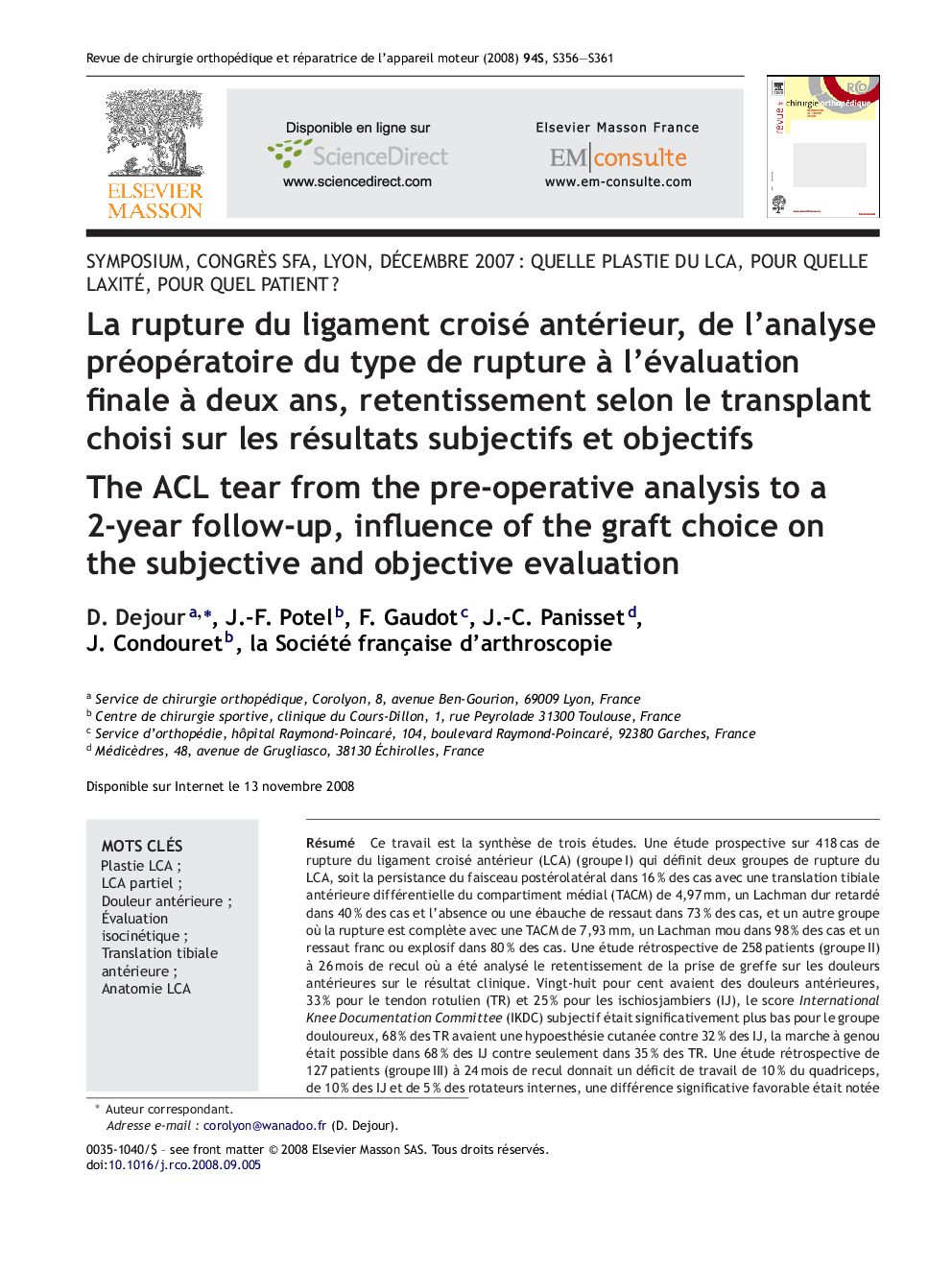| کد مقاله | کد نشریه | سال انتشار | مقاله انگلیسی | نسخه تمام متن |
|---|---|---|---|---|
| 4088175 | 1268094 | 2008 | 6 صفحه PDF | دانلود رایگان |

RésuméCe travail est la synthèse de trois études. Une étude prospective sur 418 cas de rupture du ligament croisé antérieur (LCA) (groupe I) qui définit deux groupes de rupture du LCA, soit la persistance du faisceau postérolatéral dans 16 % des cas avec une translation tibiale antérieure différentielle du compartiment médial (TACM) de 4,97 mm, un Lachman dur retardé dans 40 % des cas et l’absence ou une ébauche de ressaut dans 73 % des cas, et un autre groupe où la rupture est complète avec une TACM de 7,93 mm, un Lachman mou dans 98 % des cas et un ressaut franc ou explosif dans 80 % des cas. Une étude rétrospective de 258 patients (groupe II) à 26 mois de recul où a été analysé le retentissement de la prise de greffe sur les douleurs antérieures sur le résultat clinique. Vingt-huit pour cent avaient des douleurs antérieures, 33 % pour le tendon rotulien (TR) et 25 % pour les ischiosjambiers (IJ), le score International Knee Documentation Committee (IKDC) subjectif était significativement plus bas pour le groupe douloureux, 68 % des TR avaient une hypoesthésie cutanée contre 32 % des IJ, la marche à genou était possible dans 68 % des IJ contre seulement dans 35 % des TR. Une étude rétrospective de 127 patients (groupe III) à 24 mois de recul donnait un déficit de travail de 10 % du quadriceps, de 10 % des IJ et de 5 % des rotateurs internes, une différence significative favorable était notée entre le groupe TR et IJ sur la récupération des fléchisseur. Le déficit musculaire était corrélé à un moins bon résultat subjectif. Cette étude permet au chirurgien d’être plus précis dans la définition de la rupture du LCA, d’adapter le choix de la greffe au type de sport mais aussi au type de profession et, enfin, de définir un protocole de rééducation et de suivi plus spécifique, en particulier pour la technique aux IJ.
SummaryThis study is a synthesis of three series. The first study was prospective on 418 patients with an anterior cruciate ligament (ACL) tear (group I). Two population of ACL ruptures were identified. One population with a postero-lateral bundle preserved in 16%, the mean medial anterior tibial translation side to side was 4.97 mm, the Lachman test was delayed in 40% with no or glide pivot shift in 73%. The second population with a complete ACL tear had a mean medial anterior tibial translation side to side of 7.93 mm, the Lachman test was soft in 98% with gross pivot shift in 80%. The second study was a retrospective study on 258 patients (group II) at 26 months follow-up, it correlated the impact of the type of graft on the clinical objective and subjective results. Twenty-eight percent had anterior knee pain, 33% for the patellar tendon and 25% for the hamstrings, the subjective IKDC was significantly lower for the painful knees, and 68% of the patellar tendon had a hypoesthesia and only 32% for the hamstrings. The ability to walk on the knee was 68% for the hamstrings and 35% for the patellar tendon. The third study was retrospective on 127 patients, 24 months after ACL reconstruction (group III), all were tested on a isokinetic machine for the extensor, the flexor and the internal rotator. In the total population, a 10% extensor and flexor deficit and a 5% rotator deficit was noted. A significant difference between patellar tendon and hamstrings in terms of muscular recovery was found. It pointed out that a more specific rehabilitation should be done on the hamstring group. The muscular recovery was correlated to the highest subjective score. This study allowed the surgeon to be more specific in the ACL tear definition, to adapt the graft choice to the type of sport activity but also to the type of work the patient does and finally to modify the rehabilitation protocol for the hamstring technique.
Journal: Revue de Chirurgie Orthopédique et Réparatrice de l'Appareil Moteur - Volume 94, Issue 8, Supplement, December 2008, Pages 356–361